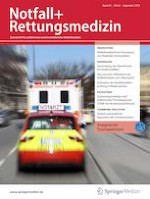11.09.2018 | Originalien
Was erwarten Mitarbeiter der Notfallmedizin vom Telenotarzt?
Ergebnisse einer Befragungsstudie vor der Einführung eines Telenotarztes in Vorpommern-Greifswald
Erschienen in: Notfall + Rettungsmedizin | Ausgabe 6/2019
Einloggen, um Zugang zu erhaltenZusammenfassung
Hintergrund
In immer mehr Regionen Deutschlands wird ein prähospitales Telemedizinsystem als Ergänzung der Regelversorgung eingeführt. Ein Telenotarzt kann von einer Zentrale aus mit Rettungsdienstmitarbeitern am Einsatzort in Echtzeit kommunizieren, diagnostisch unterstützen und therapeutische Maßnahmen delegieren. Die technische Machbarkeit und der medizinische Nutzen wurden bereits belegt. Für den dauerhaften Erfolg eines Telemedizinprojekts ist die Erwartungshaltung der Anwender essenziell. Diese wurde im Projekt Land/Rettung vor der Einführung einer Telenotarztanwendung erhoben.
Fragestellung
Was erwarten die zukünftigen Anwender (Leitstellendisponenten, ärztliches und nichtärztliches Personal im Rettungsdienst und in der Notaufnahme) von der Einführung eines prähospitalen Telemedizinsystems?
Material und Methoden
Im Mai bis August 2017 wurde die Erwartungshaltung der Personen, die mit dem Telenotarzt zusammenarbeiten werden, mittels papierbasiertem Fragebogen erhoben.
Ergebnisse
Es wurden 411 Personen kontaktiert, die Rücklaufquote betrug 51,6 %. Die Mehrheit der Befragten stimmte den Aussagen zu, dass das Telenotarztkonzept zu einer schnelleren Diagnosefindung und einem schnelleren Therapiebeginn führe und die Qualität der Patientenversorgung verbessere. Eine Verbesserung der persönlichen beruflichen Leistung sowie Reduktion der Arbeitsbelastung und des Dokumentationsaufwands werden (eher) nicht erwartet. Der Großteil der Befragten hält das Telenotarztkonzept für (eher) sinnvoll.
Diskussion
Die Mitarbeiter in der Notfallmedizin erwarten eine verbesserte Patientenversorgung durch die Einführung eines Telenotarztes. Persönliche Vorteile wie Arbeitserleichterungen werden nicht erwartet. Zusammenfassend wird das Telenotarztkonzept als sinnvoll erachtet.
Anzeige














